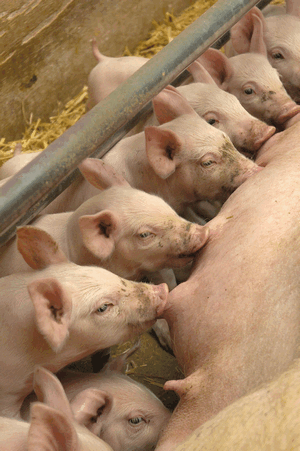Is energy the key for pig profitability?

Energy could be the prime earner for pig farmers, and pigmeat production – in financial terms – might simply become a by-product, Martin Barker, managing director of Midland Pig Producers, told last week’s ACMC conference at Beeford, Yorkshire.
With the world focus on renewable energy, he saw biogas production – converting pig manure into methane and then electricity – as a competitive way forward.
His company is developing a “Green circle pig production concept” in which the manure from 52,000 finishing pigs will be used to generate £1m of electricity a year.
“A 3 MW bio-gas plant is being built in Staffordshire and this will also process kitchen waste, which would otherwise go to landfill. In addition, the waste processing will generate income since landfill disposal fees for this amount to about £65/t.”

Value
When the waste is processed an odourless liquid is produced, a valuable fertiliser.
Midland Pig Producers is currently arranging agreements with local farmers whereby they are supplied with free seed and fertiliser and in return sell grain back at prices reflecting the value of the inputs.
The fertiliser should be sufficient for 2000ha (4942 acres) producing enough grain for 15,000t of pig feed.
Pig farmers survival might depend on energy production and such a system could make pig farming profitable again, explained Mr Barker.
Carbon footprint
The bio-digester would produce heat for piggeries as well as cheap electricity for milling grain. In addition to reducing nitrates, grain produced within the Green Circle concept would cut food miles, further reducing the carbon footprint.
Meanwhile, with the supply of commodities struggling to keep up with demand, high and volatile raw material prices are likely to remain in the foreseeable future, said Hugh Burton, raw material manager for Associated British Nutrition.
“Unfortunately, pig farmers will need to adapt to live with them. Price risk management will become increasingly important. It is hard for producers to control the end price of their product and neither can they, nor companies such as ABN, exert significant influence over the cost of feed ingredients, so some method of linking the two could be appropriate.”
Linking cost and feed
This might involve setting up a pig futures market, as in the USA, or forming closer working relationships with retailers and pig buyers, so end-product price could be linked to the cost of feed.
“Ideally, a way should be found to help processors and retailers to add value to British pigmeat products purchased by consumers.”
He said the good news was that there would be increased availability of co-products on the market from the biofuel sector, both wet and dry. “It could mean farm feeding practices will have to change to benefit from these materials.
“For example, increased bio-ethanol production would result in greater availability of distillers’ grains. Additionally, bio-diesel production from soya and oilseed rape is likely to result in more oilseed meals, which have a high protein content, on the market,” explained Mr Burton.
Pig future
- Feed price rises continue
- Closer retailer relationships
- Co-product options
- Energy production profits
